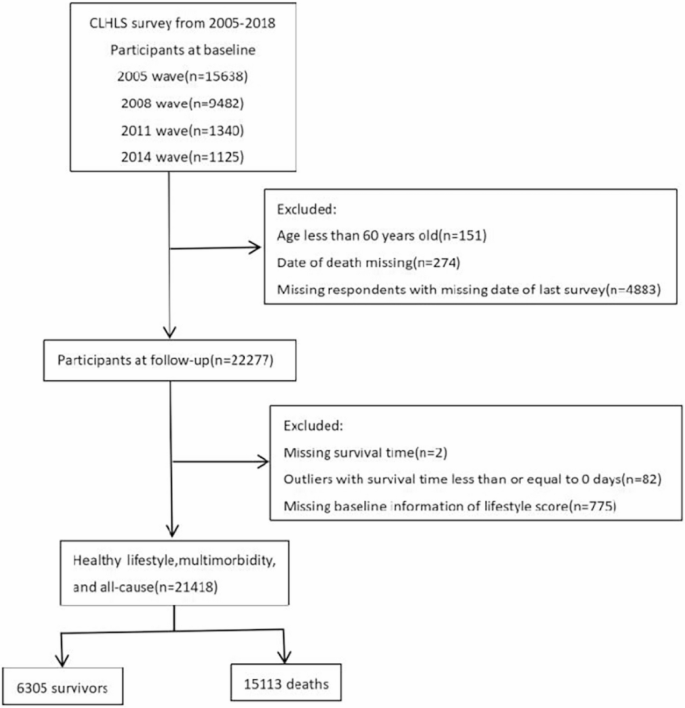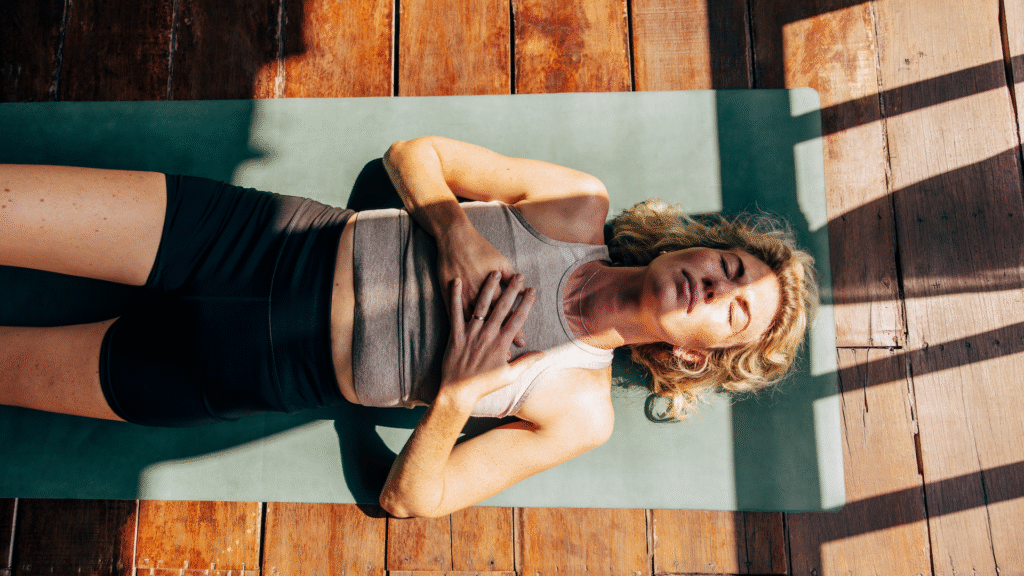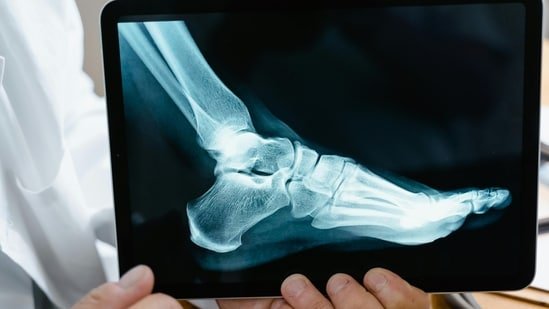Study design and participants
This study was based on data from the Chinese Longitudinal Healthy Longevity Survey (CLHLS), a nationwide longitudinal study on factors influencing health in older adults, conducted by the Center for Healthy Aging and Development Research at Peking University. The CLHLS employed a multi-stage stratified sampling design, covering 23 provinces, municipalities, and autonomous regions across China. Since its inception in 1998, the survey has primarily targeted adults aged 80 years and older, and since 2002, it has been expanded to include younger older adults (aged 65–79) as well as their middle-aged children (aged 35–64). The CLHLS dataset is distinguished by its comprehensive household and individual-level information, robust sample size, extended follow-up periods, scientific sampling structure, and strong national representativeness.
As height measurements (needed for BMI calculation) and household income data became available beginning in 2005, this study utilized data from the 2005, 2008, 2011, 2014, and 2018 waves to investigate the associations between healthy lifestyle, multimorbidity, and all-cause mortality among older people. A total of 27,585 participants were initially enrolled between 2005 and 2014. We excluded individuals aged under 60 years (n = 151), participants with missing death dates (n = 274), and those lost to follow-up with no record of the last survey date (n = 4,883), resulting in a sample of 22,277 participants. Further exclusions included participants with missing baseline healthy lifestyle data (n = 775), missing survival time (n = 2), or survival time of zero or fewer days (n = 82). The final analytic sample comprised 21,418 participants. The process of data exclusion is presented in Fig. 1.
Healthy lifestyle index (HLI)
Baseline data on lifestyle behaviors among older adults were obtained from the CLHLS. Referring to the World Health Organization’s Decade of Healthy Ageing Baseline Report [29] and previous scholarly research on healthy lifestyle [20, 30], we constructed a Healthy Lifestyle Index (HLI) comprising five modifiable components, including healthy BMI, never smoking, harmless alcohol consumption, ideal physical activity level and ideal dietary intake. Each component was scored as either 0 or 1, with a score of 1 indicating adherence to a healthy behavior.
BMI was calculated as weight in kilograms divided by the square of height in meters (kg/m²). A BMI in the range of 18.5 to 23.9 kg/m² was considered healthy [31] and scored 1, values outside this range were scored 0. Smoking status was categorized as current smoker, former smoker, or never smoker, with never smoking classified as healthy [32] and assigned a score of 1, while other categories were scored 0. Following the World Health Organization’s International Guide for Monitoring Alcohol Consumption and Related Harm, harmless alcohol consumption was defined as intake of less than 41 g of alcohol per day for women and less than 61 g per day for men [33], and was scored as 1. Physical activity was assessed based on the frequency of participation in nine types of activities: regular exercise (aerobic and anaerobic), housework, personal outdoor activities, gardening, keeping domestic pets, reading, playing cards or mahjong, watching television or listening to the radio, and socializing. Responses of “almost every day” or “at least once a week” were scored 2, “at least once a month” scored 1, and “not every month but sometimes” or “never” scored 0 [20]. The total physical activity score was calculated by summing these responses, with the top 40% of the distribution defined as reflecting ideal physical activity and assigned a score of (1) Dietary intake was assessed using self-reported frequency of consumption of ten food items: fruits, fresh vegetables, meat, fish, food made from beans (tofu, etc.), tea, garlic, eggs, sugar, and salt-preserved vegetables. For sugar and salt-preserved vegetables, responses of “almost every day” or “at least once a week” were scored 0, “at least once a month” scored 1, and “not every month but sometimes” or “rarely or never” scored (2) For the remaining eight food items, the scoring was reversed: frequent consumption scored higher [34]. The total dietary score was then computed in a manner analogous to the physical activity score, with ideal dietary intake defined as the top 40% of the population [35] and assigned a score of 1.
The HLI was calculated by summing the five component scores, yielding a total score ranging from 0 to 5, with higher scores indicating a healthier lifestyle. For further analysis, HLI scores were categorized into three groups: unhealthy (0–1), intermediate (2–3), and healthy (4–5).
Multimorbidity
More than 22 chronic diseases, including hypertension, diabetes, heart disease, stroke and cerebrovascular disease, pulmonary tuberculosis, cataracts, glaucoma, cancer, prostate tumour, gastric or duodenal ulcer, Parkinson’s disease, bedsore, arthritis, dementia, epilepsy, cholecystitis, cholelith disease, blood disease, chronic nephritis, galactophore disease, uterine tumour, hepatitis were recorded in the CLHLS. Multimorbidity was defined as the co-occurrence of two or more chronic diseases in a single individual. Participants’ multimorbidity status was assessed using the survey question: “Are you suffering from any of the following chronic diseases?” Participants were divided into “with multimorbidity” and “without multimorbidity” categories based on the number of chronic diseases.
Outcomes
The primary outcome of this study was all-cause mortality. Mortality data were obtained through official death certificates when available, or alternatively reported by the participant’s next of kin, a local physician, or community committees [34, 36]. Survival time was calculated as the duration (in days) from the baseline survey until the occurrence of the outcome. For participants lost to follow-up, survival time was defined as the interval between the baseline survey and the date of the last recorded interview. Survival status was determined based on whether the participant was alive at the time of the 2018 follow-up survey..
Covariates
We identified covariates by reviewing relevant literature and analyzing confounders previously associated with healthy lifestyle, multimorbidity, and all-cause mortality, including age; gender (female/male); area of residence (urban/rural); educational attainment (< 1 year/≥1 year); living pattern (living with family/living alone); ethnicity (Han Chinese/other); marital status (married/unmarried); income.
Statistical analysis
Continuous variables were expressed as mean ± standard deviation (SD) for those following a normal distribution, or as median with interquartile range (IQR) for those not normally distributed. Categorical variables were presented as percentages (%).
We calculated age- and sex-adjusted mortality rates per 1,000 person-years using Poisson regression and estimated hazard ratios (HRs) and 95% CI for multimorbidity and all-cause mortality using Cox proportional hazard regression with follow-up duration as the time scale. First, we estimated associations between five HLI components—healthy BMI, never smoking, harmless alcohol consumption, ideal physical activity level and ideal dietary intake—and all-cause mortality in older people. Second, we assessed the independent associations of HLI, multimorbidity and risk of all-cause mortality. In addition, to assess the impact of a healthy lifestyle on the risk of all-cause mortality among participants with different multimorbidity statuses, we stratified analyses according to whether they were multimorbid or not and analyzed for age, sex, and urban-rural heterogeneity. Five models were constructed to estimate the association of healthy lifestyle and multimorbidity with all-cause mortality. Model 1 was unadjusted; Model 2 was adjusted for age and sex; Model 3 was adjusted for area of residence, educational attainment, living pattern, ethnicity, marital status, and income. To explore the potential causal relationship between HLI, multimorbidity and all-cause mortality, we constructed two additional models. Model 4 was adjusted for area of residence, educational attainment, living pattern, ethnicity, marital status, income and multimorbidity; Model 5 was adjusted for area of residence, educational attainment, living pattern, ethnicity, marital status, income and HLI. The proportional risk hypothesis was examined using Schoenfeld’s residuals. All statistical analyses were done with Stata 17.0, and two-sided P < 0.05 was considered statistically significant.
Sensitivity analysis
To examine the robustness of the results, we performed sensitivity analyses through the following: (1) addressing reverse causation by excluding participants who died within one year of baseline (Appendix Table S3, Figure S1); (2) excluding individuals with poor self-rated health status (Appendix Table S4, Figure S2); (3) since we define multimorbidity as any combinations of 2 or more chronic diseases, a combination of multiple chronic diseases may include “high impact” (e.g., diabetes and heart disease) and “low impact” (e.g., arthritis and cataracts) diseases. To illustrate the severity of the effect, we used the top-10 most common comorbidities and categorized participants into two groups: with top-10 comorbidity and without the top-10 comorbidity (Appendix Table S5, Figure S3). The previous analyses were repeated using three different methods, and no significant bias was found in our results.







